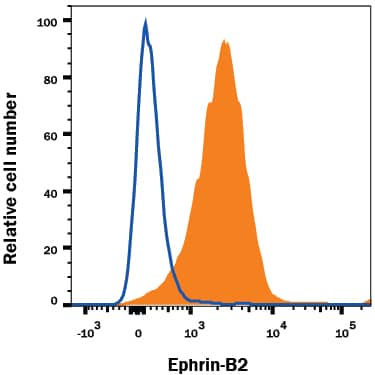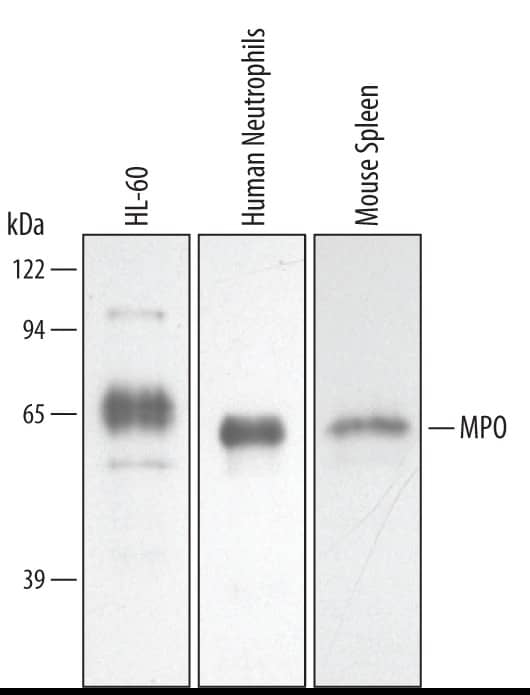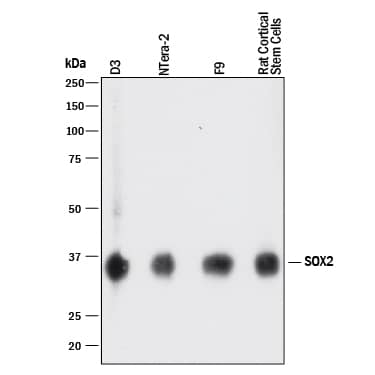Mouse 4-1BB/TNFRSF9/CD137 Antibody Summary
Val24-Leu187
Accession # P20334
*Small pack size (-SP) is supplied either lyophilized or as a 0.2 µm filtered solution in PBS.
Customers also Viewed
Applications
Please Note: Optimal dilutions should be determined by each laboratory for each application. General Protocols are available in the Technical Information section on our website.
Scientific Data
 View Larger
View Larger
Detection of Mouse 4‑1BB/TNFRSF9/ CD137 by Western Blot. Western blot shows lysates of NS0 mouse myeloma cell line either mock transfected or transfected with recombinant mouse 4-1BB/Fc chimera. PVDF membrane was probed with 0.5 µg/mL of Goat Anti-Mouse 4-1BB/TNFRSF9/CD137 Antigen Affinity-purified Polyclonal Antibody (Catalog # AF937) followed by HRP-conjugated Anti-Goat IgG Secondary Antibody (HAF017). Specific bands were detected for 4-1BB/TNFRSF9/CD137 at approximately 50-60 kDa (as indicated). This experiment was conducted under reducing conditions and using Immunoblot Buffer Group 1.
 View Larger
View Larger
Detection of 4‑1BB/TNFRSF9/CD137 in Resting Mouse Splenocytes by Flow Cytometry. Resting mouse splenocytes were stained with Rat Anti-Mouse ICOS APC-conjugated Monoclonal Antibody (Catalog # FAB168A) and either (A) Goat Anti-Mouse 4-1BB/TNFRSF9/CD137 Antigen Affinity-purified Polyclonal Antibody (Catalog # AF937) or (B) Normal Goat IgG Control (AB-108-C) followed by Phycoerythrin-conjugated Anti-Goat IgG Secondary Antibody (F0107). View our protocol for Staining Membrane-associated Proteins.
 View Larger
View Larger
Detection of 4‑1BB/TNFRSF9/CD137 in Activated Mouse Splenocytes by Flow Cytometry. Activated mouse splenocytes were stained with Rat Anti-Mouse ICOS APC-conjugated Monoclonal Antibody (Catalog # FAB168A) and either (A) Goat Anti-Mouse 4-1BB/TNFRSF9/CD137 Antigen Affinity-purified Polyclonal Antibody (Catalog # AF937) or (B) Normal Goat IgG Control (AB-108-C) followed by Phycoerythrin-conjugated Anti-Goat IgG Secondary Antibody (F0107). View our protocol for Staining Membrane-associated Proteins.
 View Larger
View Larger
4‑1BB/TNFRSF9/CD137 in Mouse Spleen. 4-1BB/TNFRSF9/CD137 was detected in perfusion fixed frozen sections of mouse spleen using Goat Anti-Mouse 4-1BB/TNFRSF9/CD137 Antigen Affinity-purified Polyclonal Antibody (Catalog # AF937) at 1.7 µg/mL overnight at 4 °C. Tissue was stained using the Anti-Goat HRP-DAB Cell & Tissue Staining Kit (brown; CTS009) and counterstained with hematoxylin (blue). Specific staining was localized to cell surfaces. View our protocol for Chromogenic IHC Staining of Frozen Tissue Sections.
 View Larger
View Larger
Detection of 4‑1BB/TNFRSF9/CD137 in NS0 cell line transfected with mouse 4‑1BB/TNFRSF9/CD137 by Flow Cytometry. NS0 cell line transfected with mouse 4‑1BB/TNFRSF9/CD137 was stained with Goat Anti-Mouse 4-1BB/TNFRSF9/CD137 Antigen Affinity-purified Polyclonal Antibody (Catalog # AF937, filled histogram) or Normal Goat IgG Control (AB-108-C, open histogram) followed by Phycoerythrin-conjugated Anti-Goat IgG Secondary Antibody (F0107). View our protocol for Staining Membrane-associated Proteins.
 View Larger
View Larger
Mouse 4 1BB/TNFRSF9/CD137 Antibody Agonist Activity. Mouse 4 1BB/TNFRSF9/CD137 Antibody (Catalog # AF937) co-stimulates IFN-gamma secretion by mouse splenic T cells in the presence of anti-CD3 epsilon (MAB484). The ED50 for this effect is typically 0.400–7.00 μg/mL.
Preparation and Storage
- 12 months from date of receipt, -20 to -70 °C as supplied.
- 1 month, 2 to 8 °C under sterile conditions after reconstitution.
- 6 months, -20 to -70 °C under sterile conditions after reconstitution.
Background: 4-1BB/TNFRSF9/CD137
4-1BB, also known as CD137 and ILA (induced by lymphocyte activation), is a TNF receptor superfamily member and has been designated TNFRSF9. Mouse 4‑1BB cDNA encodes a 256 amino acid (aa) residues type I transmembrane protein with a putative 23 aa signal peptide, a 164 aa extracellular domain, a 21 aa transmembrane domain and a 48 aa cytoplasmic region (1‑3). A soluble 4‑1BB is released from surfaces of cells expressing the transmembrane protein (4).
Mouse 4‑1BB shares approximately 60% aa sequence identity with its human counterpart. 4‑1BB is expressed on activated CD4+ and CD8+ T cells, thymocytes, and NK cells. It is also expressed on monocytes, neutrophils, DCs and eosinophils (5). The ligand for 4‑1BB (4‑1BBL), also named TNFSF9, belongs to the TNF ligand superfamily. 4‑1BBL is predominantly expressed on activated antigen presenting cells (APCs) such as B cells, macrophages and dendritic cells (DCs). It is also expressed on most T and B lymphoma cell lines. In response to 4‑1BBL binding, 4‑1BB transduce a T cell costimulatory signal in both CD4+ and CD8+ T cells to promote survival and enhance proliferation, cytokine production and effector function. In vivo, the costimulatory activity of 4‑1BB has been shown to be important in graft-vs-host disease and antiviral CTL responses. On dendritic cells, 4‑1BB is a DC-activating molecules that enhances cytokine production and up‑regulates expression of B7-1 and B7-2 costimulatory molecules, resulting in an improved ability to stimulate T cell responses (1‑5).
- Goodwin, R.G. et al. (1993) Eur. J. Immunol. 23:2631.
- Alderson, M.R. et al. (1994) Eur. J. Immunol. 24:2219.
- Kwon, B.S. and S.M. Weissman (1989) Proc. Nat. Acad. Sci. USA 86:1963.
- Wilcox, R.A. et al. (2002) J. Immunol. 168:4262.
- Kwon, B., H.W. Lee and B.S. Kwon, 2002, TRENDS in Immunology 23:378.
Product Datasheets
Citations for Mouse 4-1BB/TNFRSF9/CD137 Antibody
R&D Systems personnel manually curate a database that contains references using R&D Systems products. The data collected includes not only links to publications in PubMed, but also provides information about sample types, species, and experimental conditions.
3
Citations: Showing 1 - 3
Filter your results:
Filter by:
-
Isoproterenol Increases Uncoupling, Glycolysis, and Markers of Beiging in Mature 3T3-L1 Adipocytes.
Authors: Miller C, Yang J, England E, Yin A, Baile C, Rayalam S
PLoS ONE, 2015-09-21;10(9):e0138344.
Species: Mouse
Sample Types: Whole Cells
Applications: IHC-Fr -
Agonist anti-CD137 mAb act on tumor endothelial cells to enhance recruitment of activated T lymphocytes.
Authors: Palazon A, Teijeira A, Martinez-Forero I, Hervas-Stubbs S, Roncal C, Penuelas I, Dubrot J, Morales-Kastresana A, Perez-Gracia JL, Ochoa MC, Ochoa-Callejero L, Martinez A, Luque A, Dinchuk J, Rouzaut A, Jure-Kunkel M, Melero I
Cancer Res., 2011-01-25;71(3):801-11.
Species: Mouse
Sample Types: Whole Tissue
Applications: IHC-Fr -
Evaluation of markers of beige adipocytes in white adipose tissue of the mouse
Authors: Rolando A. Garcia, James N. Roemmich, Kate J. Claycombe
Nutrition & Metabolism
FAQs
No product specific FAQs exist for this product, however you may
View all Antibody FAQsIsotype Controls
Reconstitution Buffers
Secondary Antibodies
Reviews for Mouse 4-1BB/TNFRSF9/CD137 Antibody
There are currently no reviews for this product. Be the first to review Mouse 4-1BB/TNFRSF9/CD137 Antibody and earn rewards!
Have you used Mouse 4-1BB/TNFRSF9/CD137 Antibody?
Submit a review and receive an Amazon gift card.
$25/€18/£15/$25CAN/¥75 Yuan/¥2500 Yen for a review with an image
$10/€7/£6/$10 CAD/¥70 Yuan/¥1110 Yen for a review without an image


















